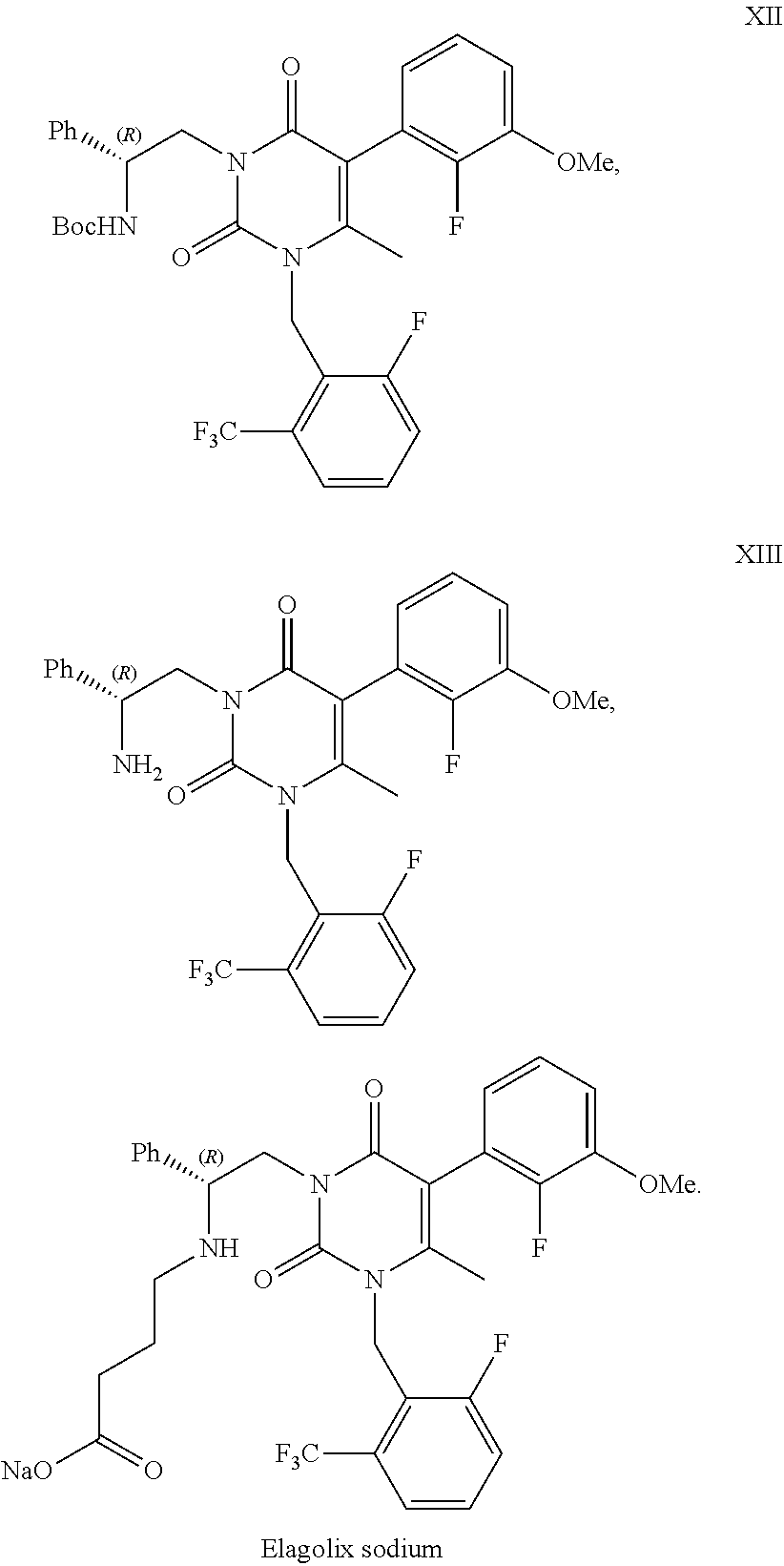Processes to produce elagolix
- Summary
- Abstract
- Description
- Claims
- Application Information
AI Technical Summary
Benefits of technology
Problems solved by technology
Method used
Image
Examples
example
Example 1: Synthesis of Compound II
[0052]
[0053]To a round-bottom flask were added compound I (20 g), tetramethylethylenediamine (15.6 g), diisopropylamine (0.6 g) and THF (200 mL). The mixture was cooled to −60˜78° C. n-BuLi solution in hexanes (53.5 mL, 2.5 M) was added at −60˜78° C. The reaction mixture was stirred at −60˜78° C. for 1 h. DMF (13.4 g) was added at −60˜78° C. After completion of the reaction, the reaction mixture was quenched with saturated NH4Cl solution (100 mL). The layers were separated. The organic phase was concentrated under vacuum. The crude material was purified by silica gel column chromatography eluting with hexane to get compound II as yellow oil (1.1 g, 4.5% yield, 99.0% purity).
[0054]1H NMR (400 MHz, DMSO-d6) δ 10.46 (s, 1H) 7.71 (m, 1H), 7.64 (d, J=7.6 Hz, H), 7.44 (t, J=9.2 Hz, 1H).
example 2
of Compound III
[0055]
[0056]To a 100 L reactor were added THF (25 L), compound I (2.5 Kg), tetramethylethylenediamine (1.95 Kg) and diisopropylamine (77.5 g). The mixture was cooled to −60˜−78° C. n-BuLi solution in hexanes (4.55 Kg, 2.5 M) was added at −60˜−78° C. After the reaction mixture was stirred at −60˜−78° C. for 1 h, DMF (1.68 Kg) was added at −60˜−78° C. After completion of the reaction, the reaction mixture was warmed to −40˜−20° C. The reaction mixture was poured into 20% AcOH aqueous solution. The layers were separated. The organic layer was added hydroxylamine hydrochloride (1.27 Kg) and sodium bicarbonate (1.02 Kg). The reaction mixture was stirred at 15˜25° C. for 1 h. After the completion of the reaction, the reaction mixture was added HCl solution. The layers were separated. The product was crystallized with EtOH / H2O to give the product as off-white solid (2.27 Kg, 72% yield, 99.3% purity).
[0057]1H NMR (400 MHz, DMSO-d6) δ 11.94 (s, 1H), 8.22 (dd, 1J=4.0 Hz, 2J=2.0...
example 3
of Compound IV
[0059]
[0060]To a 20 L reactor were added MeOH (7.1 Kg), Raney Ni (100 g), di-tert-butyl dicarbonate (1.06 Kg) and compound III (500 g), the reactor was degassed three times and refilled with H2 (0.3 MPa). The mixture was stirred at 2040° C. under H2 (0.1-0.3) MPa. After completion of the reaction, the reaction mixture was filtered to remove Raney Ni. 1 / 25 of the filtrate was concentrated to dryness. The crude product was purified by silica gel column chromatography eluting with heptane / EA to give the product as a white solid (19.01 g, 95.05% yield).
[0061]1H NMR (400 MHz, CDCl3) δ 7.47 (d, J=8.0 Hz, 1H), 7.43-7.38 (m, 1H), 7.32-7.29 (m, 1H), 4.56 (d, J=6.8 Hz, 1H), 1.45 (s, 9H).
[0062]Mass: [M-tBu+H]+: 238.1;
PUM
| Property | Measurement | Unit |
|---|---|---|
| Acidity | aaaaa | aaaaa |
Abstract
Description
Claims
Application Information
 Login to View More
Login to View More - R&D
- Intellectual Property
- Life Sciences
- Materials
- Tech Scout
- Unparalleled Data Quality
- Higher Quality Content
- 60% Fewer Hallucinations
Browse by: Latest US Patents, China's latest patents, Technical Efficacy Thesaurus, Application Domain, Technology Topic, Popular Technical Reports.
© 2025 PatSnap. All rights reserved.Legal|Privacy policy|Modern Slavery Act Transparency Statement|Sitemap|About US| Contact US: help@patsnap.com



